SLVAEV9 July 2020 – MONTH TPS63900 , TPS63901
Tech Note
The non-rechargeable lithium thionyl chloride (LiSOCl2) batteries are widely used in low current long-term applications like smart gas and water meters, asset tracking (for trucks, container, animals), building and factory automation (like alarms, motion detectors and fault indicators) and many other applications. The high capacity, high energy density and low self-discharge rate makes these batteries the ideal candidate for those long-term applications. However, the batteries have a limited output current capability and depending on the discharge rate the capacity varies significantly.
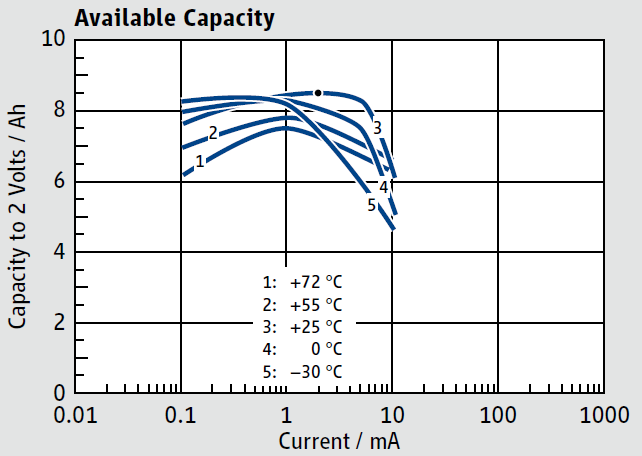 Figure 1-1 Tadiran SL-2870 Capacity
Figure 1-1 Tadiran SL-2870 Capacity As an example, look at the Tadiran SL-2870 C-Cell with rated 8.5 Ah nominal capacity. Figure 1-1 shows the capacity vs output current at different temperatures. The maximum capacity is available at 2-mA load current at 25°C. If the average load current is 10 mA the capacity drops to 6 Ah. That is a 30% reduction. This is caused by the increase of the internal resistance. At very low discharge currents the capacity drops again, as the self-discharge becomes more dominant. Furthermore, if temperature dependency is considered the ideal continuous discharge is around 2.5 mA. This ensures minimum capacity losses due to temperature.
A typical application that uses this battery is a IoT sensor node, that transmits the sensor data only a few times a day with a NB-IoT module. The standard use case is to add a big and expensive HLC in parallel with the battery and supply the system direct. This has the drawback that the HLC charging current is not controlled.
The TPS63900, a highly-efficient synchronous buck-boost converter with typical ultra-low quiescent current of 75 nA, solves this drawback by introducing a programmable input current limit (ICL). The typical ICL values are 1 mA, 2.5 mA, 5 mA, 10 mA, 25 mA, 50 mA and 100 mA. The lower current settings can be used to maximize the capacity of the LiSOCl2 battery. The efficiency of greater than 90% for 10 -μA load currents is not impacted, when ICL is used.
Figure 1-2 shows the typical implementation of the system using the TPS63900. TPS63900 is used to limit the current drawn from the LiSOCl2 battery. This maximizes the battery capacity as previously described. With the limited current a storage element (for example, 2s EDLC supercapacitor or an HLC) is charged. This element in turn provides the current needed for the data transmission.
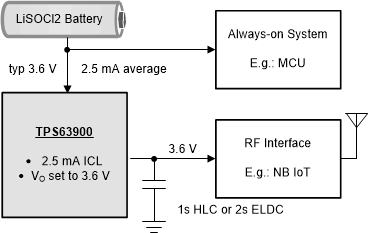 Figure 1-2 Typical Implementation Example
for Increasing LiSOCl2 Battery Capacity
Figure 1-2 Typical Implementation Example
for Increasing LiSOCl2 Battery CapacityIn addition, as described in this application note, dynamic voltage scaling (DVS) can extend the battery lifetime. It helps to save energy by lowering the supply voltage of the always on system part during low power periods. Figure 1-3 shows a modification of Figure 1-2 that combines the advantages of the ICL function and DVS of TPS63900.
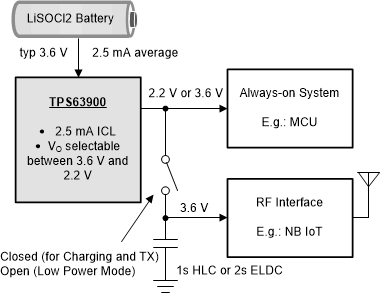 Figure 1-3 Advanced Implementation
Example for Increasing LiSOCl2 Battery Capacity Using DVS
Figure 1-3 Advanced Implementation
Example for Increasing LiSOCl2 Battery Capacity Using DVSWhen the ICL is active, the converter measures in each switching cycle how much current is transferred from the input to the output. With this information and the knowledge of VI and VO, the converter regulates the pause length between two switching cycles to keep the average input current at the set target. The inductor peak current is limited to typical 300 mA. The electric charge needed per switching cycle is provided from the input capacitor. With a typical switching cycle period of 1 μs and 300 mA peak current, only 0.3 μAs charge needs to be supplied. The input current pulses are filtered by the input capacitance and the battery internal impedance. The typical LiSOCL2 battery impedance is 1 Ω. Figure 1-4 shows the efficiency with ICL activated for VI = VO = 3.3 V.
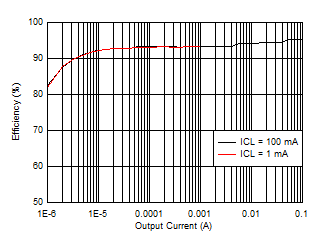 Figure 1-4 TPS63900 Efficiency With ICL
Active
Figure 1-4 TPS63900 Efficiency With ICL
ActiveThe following figures are measured at a nominal supply voltage of 3.6 V. A series resistance of 1 Ω is inserted to mimic the LiSOCL2 battery impedance. The input capacitance is increased to 100 μF to filter the switching peaks. The output voltage is set to VO = 3.3 V and CO = 330 μF. Figure 1-5 shows the start-up of the converter with 2.5 mA ICL. Figure 1-6 shows the behavior when a 100-mA load step is applied.
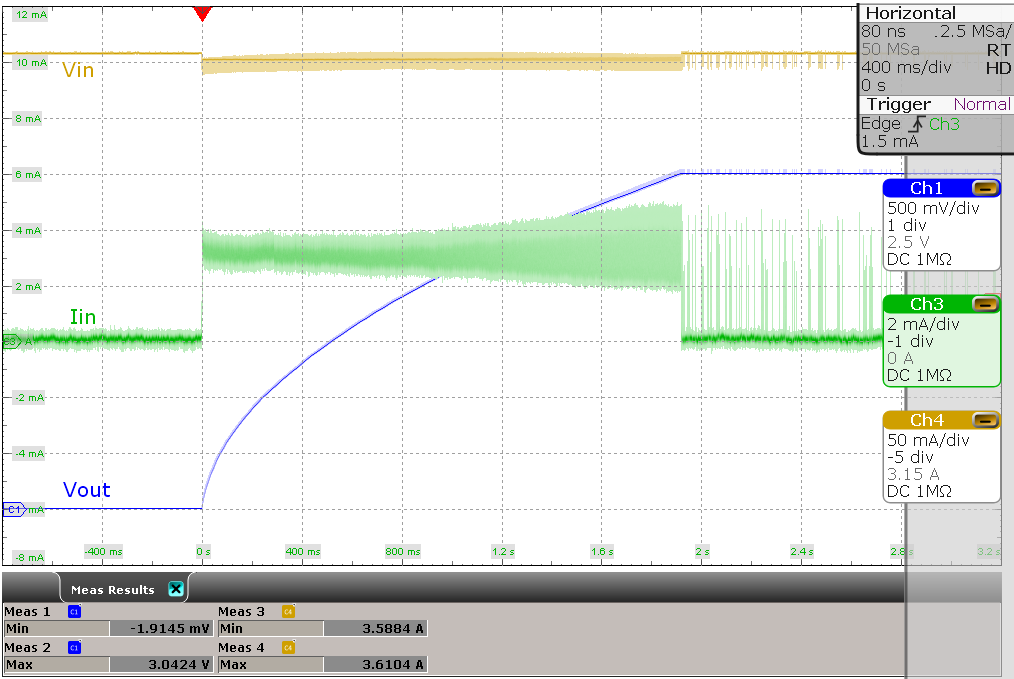 Figure 1-5 2.5-mA ICL at
Start-up
Figure 1-5 2.5-mA ICL at
Start-up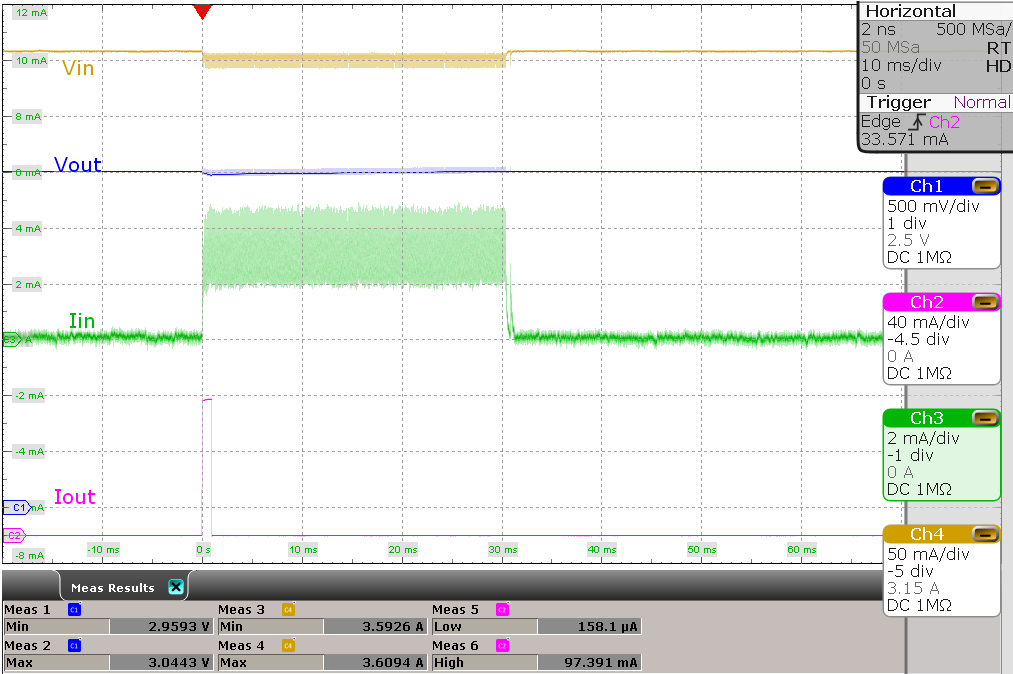 Figure 1-6 2.5-mA ICL
With 100-mA Load Step
Figure 1-6 2.5-mA ICL
With 100-mA Load Step